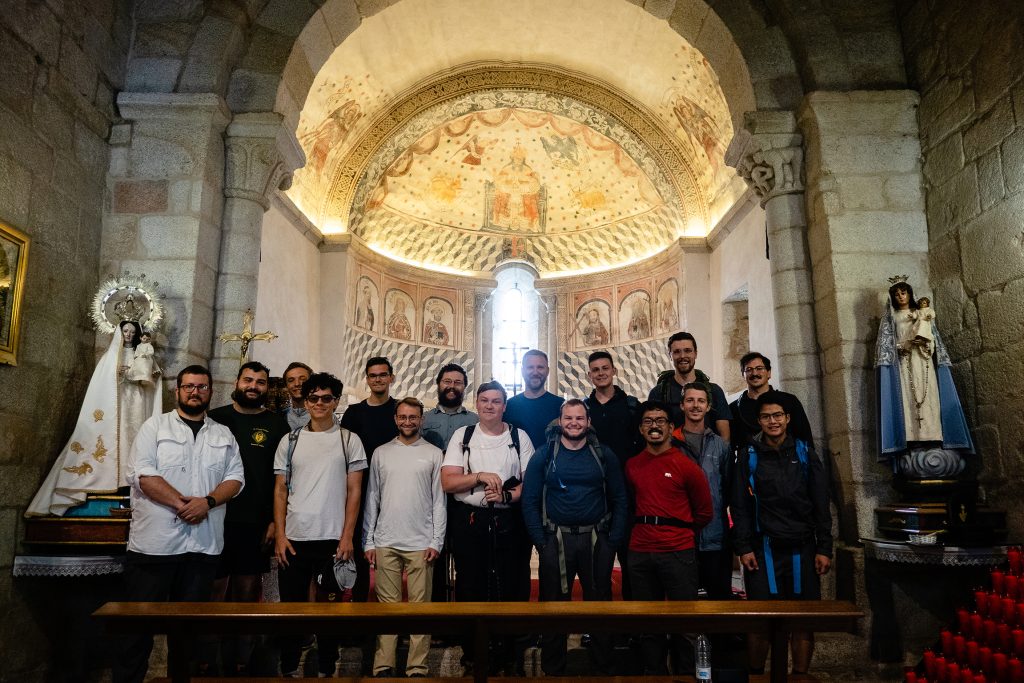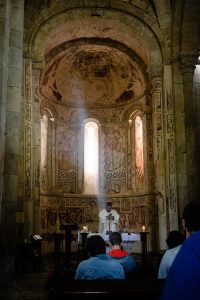Propaedeutic Stage Wraps Up Year One on the Camino di Santiago

The story below was originally published in The Athenaeum, MTSM’s bi-annual magazine. The Athenaeum is published twice a year for alumni, patrons and friends of Mount St. Mary’s Seminary & School of Theology. To be added to the mailing list, contact: Heidi Walsh at 513.233.6159 or hwalsh@athenaeum.edu.

Last academic year, Mount St. Mary’s Seminary & School of Theology completed its first academic year under the new Program of Priestly Formation (PPF), which shifted the focus of formation into four “dimensions” (human, spiritual, intellectual and pastoral). From there, advancement by seminarians to the next dimension of their formation would be done in stages.
The biggest change was the introduction of the Propaedeutic Stage, a pre-academic stage requiring 12 months of concentration on vocational discernment. The men of MTSM who took part in the first propaedeutic stage finished out the year by traveling to Spain to walk part of the Camino di Santiago, completing the stage from Sarria to Santiago on foot, a distance of approximately 70 miles.
“Along with Fr. Brausch and the Formation Team, we envisioned this “capstone experience” as an opportunity to make a pilgrimage that would involve communal solidarity and ample time for personal reflection,” Rev. Daniel K. Hess, Director of the Propaedeutic Stage said.
“It was beautiful to be able to travel as a group,” Seth Rinderle, an Archdiocese of Cincinnati seminarian in the Discipleship Stage, said. “The Camino is seen as a journey for the self, but for us it was also a journey as a class.”
The “Way of St. James” is a series of pilgrimage trails that leads to the same place, Santiago de Compostela in the Northwest Spanish region of Galicia. At the end of the route is the Catedral Basílica de Santiago de Compostela, where the tomb of St. James is located. The full Camino Francés extends over 600 miles, beginning in Saint-Jean-Pied-de-Port, France.
“From our conversations, I believe that each of the men had a unique and very personal experience,” Fr. Hess mentioned. “The people, churches and shrines we encountered all enriched our faith, capped by the incredible Catedral Basílica de Santiago de Compostela. It overwhelms with its beauty and liturgies.”
“With the Mass in Spanish, I did not fully understand what was going on,” Rinderle mentioned. “However, you could see the beauty of the Mass and the aspects of the faith come together, and that was beautiful in itself.”
For Rinderle, from Versailes, Ohio, this was also his first time travelling outside of the United States.
“It was a good experience and it was really good to have my brothers and Fr. Hess there,” he said. “You know your classmates, you have lived with them, but then when you go on a completely new experience with them, you continue to learn more about them.”
After a year dedicated to vocational discernment and being more removed from the rest of the seminary community in addition to the technology fast that limited the use of phones and computers, Fr. Hess saw the Camino as a way of “reentering” the world, but with a newly built perspective.
“The men encountered the Camino with a broader perspective of the universal Christian experience of leaving everything behind to seek out, and actively pursue, something worth sacrificing for,” Fr. Hess observed. “The Camino confirmed these themes form the entire year, and has prepared the men to enter the Discipleship Stage of formation.”
For Rinderle, those moments have helped him as he navigates the next stage of his formation.
“Just like we travel through our faith life, there are moments we encounter God at a closer impact and there are moments where we know He is there, but He is not as active,” Rinderle said. “That has been helpful to me throughout this stage of my formation.”